
About UsThe Numismatic Bibliomania Society is a non-profit organization devoted to the study and enjoyment of numismatic literature. For more information please see our web site at coinbooks.org SubscriptionsThose wishing to become new E-Sylum subscribers (or wishing to Unsubscribe) can go to the following web page link MembershipThere is a membership application available on the web site Membership Application To join, print the application and return it with your check to the address printed on the application. Membership is only $20 to addresses in the U.S., $25 for First Class mail, and $30 elsewhere. For those without web access, write to: David M. Sundman, Treasurer
AsylumFor Asylum mailing address changes and other membership questions, contact David at this email address: dsundman@LittletonCoin.com SubmissionsTo submit items for publication in The E-Sylum, just Reply to this message, or write to the Editor at this address: whomren@gmail.com BUY THE BOOK BEFORE THE COIN |
- WAYNE'S WORDS: THE E-SYLUM MARCH 15, 2015
- LAKE BOOKS SALE #121 CLOSES APRIL 14, 2015
- BOOK REVIEW: THE 1822 GOLD HALF EAGLE
- BOOK REVIEW: ISLE OF MAN PAPER MONEY
- BOOK REVIEW: COINED
- LAURESE KATEN 1917-2014
- MORE ON HARRINGTON MANVILLE
- ANS LIBRARY CATALOGUER JAMES WOODSTOCK
- AMERICAN COINS CHOPPED TO BITS FOR CHANGE
- NOTES FROM E-SYLUM READERS: MARCH 15, 2015
- SHORT SNORTERS STOLEN AFTER PORTLAND ANA
- NUMISMATOLOGY AND WILLIAM SUNDAY
- SUBSCRIBER PROFILE: DAVID SCHENKMAN
- WEST POINT STRIKES MARCH OF DIMES SILVER DOLLAR
- HARRAH’S CASINO SANDBLASTED SILVER DOLLARS
- IDAHO INSANE ASYLUM TOKENS
- MORE MENTAL HOSPITAL TOKENS
- ELIZABETH HARRIS'S REPLICA VICTORIA CROSS
- CONFEDERATE HALF DOLLAR PEDIGREE RESEARCH
- POGUE FAMILY COLLECTION EXHIBITED IN LONDON
- THE THOMAS B. LOCKWOOD COLLECTION
- COCOS ISLAND TREASURE FOUND BY PARK RANGERS
- COINS FOUND IN A CAVE IN ISRAEL
- ARTICLE REMOVED
- WAYNE’S NUMISMATIC DIARY: MARCH 15, 2015
- BELGIUM'S WATERLOO COIN DESIGN UPSETS FRANCE
- ARTICLE PROFILES CANADIAN COIN DESIGNER RICHARD HUNT
- ALAN KELLY ON ISLE OF MAN PAPER MONEY
- ARE THE DAYS OF PHYSICAL CASH NUMBERED?
- MAN JAILED FOR PASSING COUNTERFEIT £1 COINS
- HOW DO TOY BANKNOTES GET PAST CASHIERS?
- MORE 'COUNTERFEITING IN REVERSE' SCAMS
- JACK THE COIN-SWALLOWING CAT
- WOMAN BURNS CASH STASH BY MISTAKE
Click here to access the complete archive
To comment or submit articles, reply to whomren@gmail.com
WAYNE'S WORDS: THE E-SYLUM MARCH 15, 2015

New subscribers this week include: Todd Hughes, courtesy of John and Nancy Wilson; Nelson Wolbert, and Paul Armes. Welcome aboard! We now have 1,828 subscribers
This week we open with an update from Fred Lake, and three numismatic book reviews. Other topics include Laurese Katen, Harry Manville, William Sunday, Dave Schenkman, mental hospital tokens, the Confederate Half Dollar, the second battle of Waterloo, and the mischievous moggy.
To learn more about the 1822 Half Eagle, Isle of Man paper money, coins chopped to bits for change, stolen short snorters, sandblasted silver dollars, and the Thomas B. Lockwood collection, read on. Have a great week, everyone!
Wayne Homren
Editor, The E-Sylum
LAKE BOOKS SALE #121 CLOSES APRIL 14, 2015
Lake Books’ 121st mail-bid sale of numismatic literature is now available for viewing on its website at www.lakebooks.com/current.html . The 438-lot catalog is notable for many special hardbound editions of well-known collections including Library Editions. Of special interest is Volume III of “American Journal of Numismatics” which contains a fine photograph of the First Mint Building and another that shows the Cents of 1793 prepared by J.N.T. Levick for Crosby’s work on that year.
A number of early “Redbooks” are offered including a first edition, first printing copy that bears the autograph of R. S. Yeoman. Works on Latin American coinage are well represented along with specialized material on paper money, tokens and medals, plus United States coinage.
Bids may be placed via email, telephone or fax until the closing time of 5:00 PM (EDT), April 14, 2015. Be sure to bid early as ties are won by the earliest bid received.
Good Luck with your bidding…..Cordially, Fred
Lake Books
6822 22nd Ave N
St. Petersburg, FL 33710-3918
727-343-8055 fax: 727-381-6822
BOOK REVIEW: THE 1822 GOLD HALF EAGLE

For his treatment of the Pogue Collection, Bowers lets the coins speak for themselves. And boy, do they.
The 1822 half eagle gets full court press as the sole subject of Bowers’ ... book. It’s as rare a U.S. coin as they come. Out of the reported mintage of 17,795, only three genuine specimens have ever materialized.
For more than a century and a half, one has served as the centerpiece of the United States Mint’s Mint Cabinet and one is in the Smithsonian Institution’s National Numismatic Collection. The second was gifted to the Smithsonian in 1967 by the estate of collector Josiah K. Lilly in exchange for tax relief from the United States Congress. At the time, the Lilly collection–including the 1822 half eagle–was valued at $5,534,808.
The Pogue Specimen traces its pedigree back to the 19th century numismatic sale of the collection of Hiram E. Deats. The cataloger, Edouard Frossard, offered no explanation as to the origins of the coin and Deats’ cabinet contained no other major rarities. For whatever reason, the lot wasn’t allowed to sell and later showed up in the collection of Mauritius David. From there, the list of owners is short and legendary: Brand, Eliasberg, Pogue.
Although the practice of writing monographs has more or less fallen by the wayside over the years, Bowers’ treatment of the 1822 reads like one.
Using the best available information, it describes the minting of the issue in detail and follows the chain of custody for the three known examples through the 19th and 20th centuries. It’s important to note that no 1822 half eagle has changed hands since the Eliasberg Sale in 1982.
Which is why, in our opinion, the 1822 is in many respects undervalued. Perhaps not in dollars–some estimate the coin will fetch more than $10 million, others we’ve spoken to suggest $7 or $8 million–but in the consciousness of the collecting public.
For this we have a theory. The 1822 is not a controversial coin. It wasn’t illegal to own for 70 years like the 1933 Saint. It was not, so far as anybody knows, restruck surreptitiously by employees of the U.S. Mint to capitalize on the small but very real coin collecting craze of the mid-19th century, like the novodel 1804 dollar.
Furthermore, there has never been an effort to “mainstream” the coin by publishing sensationalistic tales about it or overly hyping it up. It is, as it’s always been, a great rarity meant to be enjoyed by the select few.
It’s been 35 years since the last opportunity came up. It’ll take millions of dollars more to lock it away again.
To read the complete article, see:
First Read: The 1822 Gold Half Eagle: Story of a Rarity and Treasures from the D. Brent Pogue Rare Coin Cabinet: A National Legacy
(www.coinweek.com/education/first-read-the-1822-gold-half-eagle-story-of-a-rarity-and-treasures-from-the-d-brent-pogue-rare-coin-cabinet-a-national-legacy/)
BOOK REVIEW: ISLE OF MAN PAPER MONEY
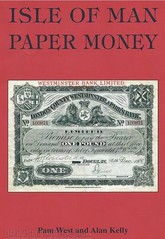 You do not have to be a collector of Isle of Man notes to recognise the contribution this book makes to
our understanding of the notes issued on this small island in the Irish Sea, part of the British Isles geographically but not part of the
United Kingdom politically.
You do not have to be a collector of Isle of Man notes to recognise the contribution this book makes to
our understanding of the notes issued on this small island in the Irish Sea, part of the British Isles geographically but not part of the
United Kingdom politically.
Pam West and Alan Kelly have reviewed and catalogued every example of paper money ever issued on the Isle of Man. There have been earlier catalogues but none is as comprehensive in its coverage and this is the first one to provide a complete pricing guide.
The book opens with an extensive introduction chapter contributed by Jonathan Callaway covering not only the historical background but also a brief outline of the currency history of the Island. The first section of the catalogue proper covers the many early 19th century card money issues which were abolished in 1817. Many new discoveries have been listed and many new images of these rare pieces are included. The authors have trawled not only institutional collections on the Island and elsewhere but also gained access to the leading private collections.
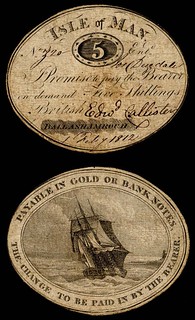 The next section deals with the first banknotes proper on the Island, starting in 1788 and covering the
early issues ahead of an Act of the Tynwald (i.e. the Isle of Man’s own parliament) in 1817 which set out the Isle of Man’s first
regulations for banknote issuance. The ensuing chapter covers firstly the various private banks licensed to issue notes under the 1817 Act.
Once again many previously unknown notes have been found and illustrated. The chapter then goes on to cover the Isle of Man’s first joint
stock banks. These better capitalised banks did eventually drive the private banks out of business but not without a few casualties of
their own. There are potted histories of each one including the ill-fated Bank of Mona which abruptly ceased trading when its Scottish
parent collapsed catastrophically in 1878. Each bank’s note issues are carefully set out with every signature variety described and
illustrated. Proofs and essays are also listed and where possible illustrated.
The next section deals with the first banknotes proper on the Island, starting in 1788 and covering the
early issues ahead of an Act of the Tynwald (i.e. the Isle of Man’s own parliament) in 1817 which set out the Isle of Man’s first
regulations for banknote issuance. The ensuing chapter covers firstly the various private banks licensed to issue notes under the 1817 Act.
Once again many previously unknown notes have been found and illustrated. The chapter then goes on to cover the Isle of Man’s first joint
stock banks. These better capitalised banks did eventually drive the private banks out of business but not without a few casualties of
their own. There are potted histories of each one including the ill-fated Bank of Mona which abruptly ceased trading when its Scottish
parent collapsed catastrophically in 1878. Each bank’s note issues are carefully set out with every signature variety described and
illustrated. Proofs and essays are also listed and where possible illustrated.
The complex history of Dumbell’s Bank comes next, again with illustrations of a number of very rare notes and a fully detailed listing of the bank’s issues. This bank failed in 1900 and creditors got just 12s 7½d (63p) in the pound although the note holders were paid out in full – hence fully issued notes are rare today.
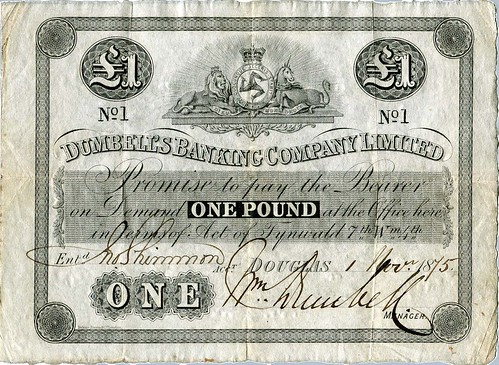
The final note issuing bank to be established on the Isle of Man was the Isle of Man Joint Stock Banking Company Limited, in November 1865. The bank’s issues are covered with the same degree of detail as previous issuers but there is more – when Waterlow & Sons Ltd took over the printing contract in 1927 they used the positional plate letters seen on all the notes they produced. Here the book sets out the plate letter sequences in remarkably full detail. A total of 530,000 £1 notes were printed by Waterlows with one master plate for each side of the note, each with four impressions on it. Each impression was given its own plate letter and the book lists in full the complex pattern of plate letters, prefixes and dates. The original master plates were re-engraved in 1952 and each of the four impressions given a new plate letter. On top of this there were frequent signature changes and again these are set out in complete detail. For specialist collectors this is as good as it gets! Waterlow also printed 7,200 £5 notes for the bank between 1927 and 1960. Such a tiny print run required just one plate for each side but there are still five date and signature varieties to collect despite the fact that 2,600 of these notes were never issued.
In 1896 saw the first of the English banks arrive to offer the local banks serious competition. Four English banks eventually issued their own notes. These issues are popular with many collectors due to the fact that they are the only banknotes any of these banks ever issued; they were unable to issue notes in England itself due to a different legislative environment and the dominance of the Bank of England. Once again the book does not let collectors down and provides every level of detail on type, variety and signature changes through to 1961 when the Tynwald withdrew the right for commercial banks to issue their own notes.
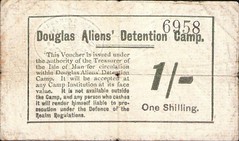 The book next devotes a long chapter to the Internment Camp issues from both World Wars. As a
small island located midway between Britain and Ireland, the Isle of Man was deemed to be an ideal location to intern ‘enemy aliens’ during
both global conflicts. These were civilians originally from the countries the United Kingdom found itself at war with. Many of the camps
issued their own ‘currency’ in the form of vouchers and canteen tickets. The many issues are covered here in unparalleled detail with many
issues recorded and illustrated for the first time. A wealth of new information is offered and much fascinating background is provided on
the camps themselves.
The book next devotes a long chapter to the Internment Camp issues from both World Wars. As a
small island located midway between Britain and Ireland, the Isle of Man was deemed to be an ideal location to intern ‘enemy aliens’ during
both global conflicts. These were civilians originally from the countries the United Kingdom found itself at war with. Many of the camps
issued their own ‘currency’ in the form of vouchers and canteen tickets. The many issues are covered here in unparalleled detail with many
issues recorded and illustrated for the first time. A wealth of new information is offered and much fascinating background is provided on
the camps themselves.
The final third of the book focuses on the issues of the Isle of Man Government – a much loved and widely collected series which has been running for over 50 years and still going strong. All these beautiful notes carry a portrait of H.M. Queen Elizabeth II and the many varieties and signature changes are naturally covered in the full detail we have come to expect. Nearly every known proof, specimen and colour trial is illustrated and once again a lot of new information has been unearthed for collectors to enjoy.
‘Isle of Man Paper Money’ covers well over 200 years of paper money history in its 412 pages. It achieves a level of detail few catalogues can aspire to and will stand for many years as the definitive guide to the Isle of Man’s paper currency issues. The book is beautifully produced and all illustrations are in full colour. This reviewer cannot recommend this book enough. It would grace the shelf of any paper money enthusiast and surely whet the appetite of anyone who has yet to start collecting these fascinating and lovely notes.
Pam West writes:
The book is available at £24 plus post from our site – it is on the front page or in the Books section. I appreciate you are overseas and those reading will be from overseas, however, we treat each book order separately and seek the best posting option (giving as much choice as possible). We will have some copies for sale at the Memphis show. People can pre-order with me.
For more information, or to order, see:
www.britishnotes.co.uk/?page=stock_item&categoryid=18&stockid=28798

BOOK REVIEW: COINED
 I had the pleasure of reviewing the book entitled "Coined" which was
just published.
I had the pleasure of reviewing the book entitled "Coined" which was
just published.
Kabir Sehgal traveled the world , interviewed coin people of great note, and bankers who could give him the background on coins and how they were developed in different parts of the world. It is a wonderful piece of research and relates to all the development of money, in a narrative form, that is extremely informative about Money as well as its origin and how it developed.
I had a lengthy interview with him to try to help develop his story. My son , Larry and I spent endless hours reading and re-reading the stories he relates as they all have Numismatic Background, the origin and development of Coins as money, and presented in a travelogue narrative which is extremely informative and quite lively,
I was quoted mid-way in the story, as he came to the United States to discuss Coins and Money in his travels. He was just interviewed in BloombergTV Money, and he introduced the History of Coins there.
Kabir is a senior Vice President of J.P. Morgan and is very well informed on monetary matters. He traveled to about 50 places worldwide to research his book.
The importance of money in our lives is readily apparent to everyone--rich, poor, and in between. However grudgingly, most of us accept the expression "Money makes the world go round" as a universal truth. We are all aware of the power of money--how it influences our moods, compels us to take risks, and serves as the yardstick of success in societies around the world. Yet because we take the daily reality of money so completely for granted, we seldom question how and why it has come to play such a central role in our lives.
In Coined: The Rich Life of Money And How Its History Has Shaped Us, author Kabir Sehgal casts aside our workaday assumptions about money and takes the reader on a global quest to uncover a deeper understanding of the relationship between money and humankind. More than a mere history of its subject, Coined probes the conceptual origins and evolution of money by examining it through the multiple lenses of disciplines as varied as biology, psychology, anthropology, and theology. Coined is not only a profoundly informative discussion of the concept of money, but it is also an endlessly fascinating and entertaining take on the nature of humanity and the inner workings of the mind.
Kavan Ratnatunga writes:
I met him on 2013 November 27th and I am glad to see his interview with me in the last chapter of the Book among five collectors. I have just seen it on Kindle edition that my son Rhajiv purchased for me.
For more information, or to order, see:
www.coinedbook.com
LAURESE KATEN 1917-2014
Dave Hirt writes:
She was the clerk at Frank's sales reading out the mail bids and noting the buyer numbers. Her hobby was raising and showing miniature Schnauzer show dogs.
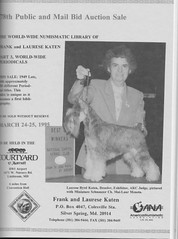
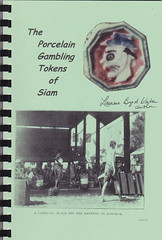
David Gladfelter writes:
In addition to working with Frank in the Katen numismatic book business, Laurese bred and exhibited championship schnauzer dogs. Her picture with one of her dogs is on the cover of the Katens' 78th public and mail bid auction sale catalog of the world wide periodical section of their library ... Laurese, Frank's second wife, was about 10 years younger than he, who died on his 98th birthday in 2001.
In the 1990s Laurese was editor of the MANA Journal published by the former Middle Atlantic Numismatic Association. In 1997 MANA and the former Great Eastern Numismatic Association (GENA) merged into the Eastern States Numismatic Association. She wrote an illustrated booklet on the porcelain gambling tokens of Siam, published in 2002. They lived in rural Silver Spring, MD, where they had a home office. They were good friends of the late John Huffman and Gordon Frost.
LAURESE BYRD KATEN
On Friday, December 12, 2014, LAURESE BYRD KATEN of Silver Spring, MD. Beloved wife of the late Frank J. Katen; loving mother of Larry K. Pusey. Also survived by other loving family and friends. A gathering will be held at the Inter-Faith Chapel at Leisure World, 3680 South Leisure World Blvd., Silver Spring, MD on Wednesday, December 17, 2014 from 9:30 a.m. until time of service at 10:30 a.m. Interment Gate of Heaven Cemetery, Silver Spring, MD.
To read the complete article, see:
LAURESE B. KATEN
(www.legacy.com/obituaries/washingtonpost/obituary.aspx?pid=173481886)
MORE ON HARRINGTON MANVILLE
Bill Snyder writes:
I was sorry to hear that Harry Manville has passed away. Harry and I were great corresponding friends in the 1980's and 1990's.
We each collected mis-struck milled English coins. I specialized in coppers (Charles II to William IIII); he in silver pieces (Charles II to George III). Brockages and dramatic Double Strikes were our 'thing'.
Over the years, he alerted me when an interesting copper piece showed up for sale in the UK (like my double-struck Cartwheel penny); I wrote to him when a double-struck George III half crown appeared in San Francisco, etc.
From time to time, he mentioned other areas of interest. He collected the rare silver Gunmoney pieces, for example.
I always read his letters with great interest. Sadly, we lost touch some years ago. I will miss him.
ANS LIBRARY CATALOGUER JAMES WOODSTOCK
We are pleased to announce the hiring of James Woodstock as a part-time cataloguer in the Society’s Harry W. Bass Jr. Library. James brings with him years of library experience, including five as a cataloguer at Touro College Law Center in New York City. He also currently holds a position as an adjunct cataloguer at the Academy of Jewish Religion in Yonkers. In addition, James has a reading knowledge of Western European, Slavic, and some Asian languages, and a bibliographic reading proficiency in Hebrew, Arabic and Greek, skills that are sure to come in handy when processing the multilingual collections of the ANS.
To access the ANS library catalog, see:
http://donum.numismatics.org/
THE BOOK BAZARRE
AMERICAN COINS CHOPPED TO BITS FOR CHANGE
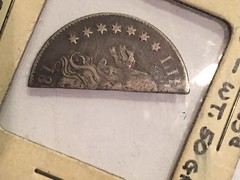
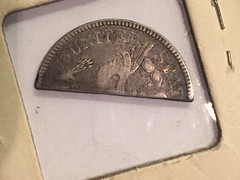
Half of an 1805 Quarter
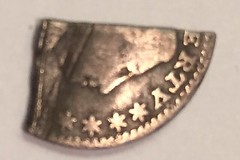
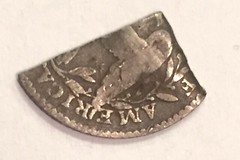
Quarter of a 1795 Half Dime
David Ganz writes:
It's unlikely that coinage would be chopped into bits after 1874 because of title 18 (criminal laws) . The 1874 Revised Statutes (SECTION 5459) PROVIDES THAT ANYIONE WHO "DEFACESS MUTILATES, IMPAIRS, DIMINISHES..." ANY us COIN MAY BE FINED and imprisoned, (See my book on US Coinage Laws before 1894 (Bowers, 1990), p. 58.
Just a non sequitur thought that is tangentially related: my book on bicentennnial coinage, published in 1976 which originally appeared as a multi-part series in The Numismatist) was called Fourteen Bits because my publisher (3 Continents Press) was so fascinated by the thought of breaking off a portion of the currency to get change.
To read the earlier E-Sylum article, see:
NEW BOOK: THE COINS OF FORT ATKINSON
(www.coinbooks.org/esylum_v18n10a04.html)
NOTES FROM E-SYLUM READERS: MARCH 15, 2015
The Kings Private Roads Token
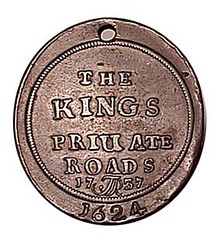
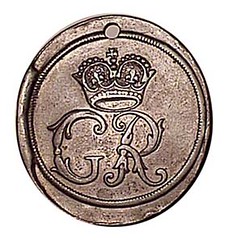
2683. TRANSPORTATION: "The Kings Private Roads", 1737. Classic old style oval pass for the King's Private Road from St. James's Palace to Hampton Court. Carried by government messengers, used as a pass to travel the Royal roads. C/m 1624; rev crowned GR florate letters of George II. Smith-908H, Neumann 28358. Davis and Waters ("Tickets and Passes of Great Britain and Ireland") state the top hole, as made, was for attaching gate keys (no key with this specimen). Beautiful Brown VF. CU, 32x35mm. Clear, clean (but not cleaned!) and Nice! Greatly superior to Bendall's plates. RARE and highly desirable!
To read the earlier E-Sylum article, see:
ADMISSION TICKETS & PASSES : Chelsea, The King's Private Roads
(www.coinbooks.org/esylum_v18n10a22.html)
Kudos for John Humphris
Howard Daniel writes:
I wanted to comment on John Humphris and his wife. A great couple and I learned a lot from them when they were dealing in the USA. Phung and I stopped in their shop in London a couple of times, and then went into the British Museum for me to do a little research. Phung started her medal collection because of them.
Dusty Royer writes:
I enjoyed the information on John Humphris. I met John and his wife Margaret in late 60s and enjoyed their friendship and knowledge. I will always be grateful for the invitation John was able to get for me to examine the Ancient Coin Cabinets at the British Museum. With John's introduction, I was able to see and examine 100s of rare coins. Even my son, Jeff, who has no interest in anything numismatic, found it fascinating. Thanks again John!
To read the earlier E-Sylum article, see:
SUBSCRIBER PROFILE: JOHN HUMPHRIS
(www.coinbooks.org/esylum_v18n10a11.html)
SHORT SNORTERS STOLEN AFTER PORTLAND ANA
The Centralia, Washington police department is investigating a vehicle burglary that resulted in the theft of exhibit panels from the Short Snorter Project. The victim who had exhibited at the ANA Portland show was on his way home when the offense occurred. The suspects gained entry into the victim's trunk and removed five of the exhibits ten panels.
List of stolen items:
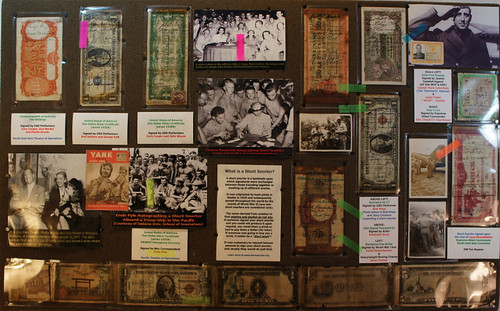
Panel #1 (20" x 32" plywood covered by olive green colored fabric) Inventory: (All notes mounted in currency sleeves)
1. Australia ten shillings signed by Gary Cooper, Una Merkel, and Phyllis Brooks.
2. US one dollar signed by Red Skelton, George Raft, et al.
3. US one dollar "Funny Back" signed by Gary Cooper, John Wayne, Vikki Montan, et al.
4. Suriname half gulden signed by Bob Hope, et al (heavy tape degredation).
5. India five rupees signed by ("WASP-Seattle"), Capt. Hank Greenberg, et al.
6. Italy five lire signed by General Dwight D. Eisenhower, et al.
7. U.S. one dollar HAWAII overprint signed by Randolph Scott, et al.
8. Barbados one dollar signed by Eddie Rickenbacker, Gene Tunney, et al
9. Long short snorter with U.S. one dollar HAWAII overprint signed by Ernie Pyle, et al. and five foreign banknotes taped together.
10. 3 original photos: Bob Hope, Lord Louis Mountbatten(2)
Panel #2 (20" x 32" plywood covered by olive green colored fabric) Inventory:
1. Long short snorter of Florice "Folly" Langley containing a US one dollar and ten foreign banknotes with many signatures
taped together and mounted in currency sleeves. Fiji one penny is signed by Eleanor Roosevelt. India ten rupees is signed by USO troupe
(Pat O'Brien, Betty Yeaton, Jinx Falkenburg, Ruth Carrell, Jimmie Dodd, Harry Brown) et al.
2. China-Burma-India Theatre of Operations shoulder patch
3. Invitation to dinner with Mrs. Franklin D. Roosevelt and table menu
4. Invitation to Florice Langley to attend dance with 436th Bomb Squadron
5. Four WW2 photographs of Florice Langley and one WW2 photograph of Jinx Falkenburg signing a short snorter on top of an accordion with a
group of service men.
Panel #3 (20" x 32" plywood covered by gold colored fabric) Inventory:
1. Long short snorter of Marshall L. Windmiller containing a US one dollar and five foreign banknotes with many signatures taped
together and mounted in currency sleeves.
2. China banknote (green) signed by Bob Raines AVG ("Flying Tigers"), et al.
3. China fifty yuan (brown) signed by members of 29th Fighter Squadron, et al.
4. China ten yuan (red) with notation "705 SNAFU SHIPMENT" and "CHINA BURMA INDIA 1944" with many signatures.
5. India ten rupees with inscription "LEDO ROAD" signed by Major-General Daniel Sultan (US), Major-General Godfrey
Wildman-Lushington (UK), Admiral Lord Louis Mountbatten (UK), Lt. Col. A. A. C. Walker (UK), Brigadier-General Lewis Pick (US),
Brigadier-General Thomas Farrell (US), Paulette Goddard (USO).
6. China ten yuan (red) with notation "BURMA ROADSTERS" signed by General Frank D. Merrill and General Raymond A. Wheeler, et al.
Many stars on borders. "V548728J" notation.
7. China ten yuan (red) with notation "BURMA ROAD HUMP FLYERS" with many signatures.
8. India five rupees signed by USO troupe (Pat O'Brien, Betty Yeaton, Jinx Falkenburg, Ruth Carrell, Jimmie Dodd, Harry Brown).
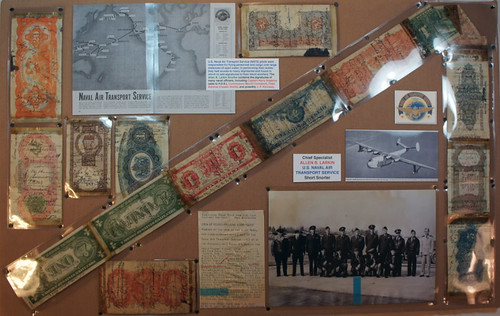
Panel #4 (20" x 32" plywood covered by gold colored fabric) Inventory:
1. Long short snorter of Allen B. Larkin, U.S. Naval Air Transport Service, containing two US one dollar and eight foreign banknotes
with many signatures taped together and mounted in currency sleeves. Notation on last two foreign banknotes pertain to "FIRST FLIGHT
USS MARS/NATS LONGEST FLIGHT OVER WATER WITH MOST CARGO PAUTUXENT TO NATAL". Mounted next to reproduction press photo of same event.
2. Six single foreign banknotes mounted individually in currency sleeves. Four shillings (pink & green) signed by Commodore Merrill
Comstock, et al (mostly US Naval Officers - One may be John F. Kennedy - unauthenticated)
Panel #5 (20" x 32" plywood covered by grey colored fabric) Inventory:
1. Long short snorter of Lee Moyne Mark, U.S. Navy Photographers Mate, containing one US one dollar and seven foreign banknotes with
many signatures taped together and mounted in currency sleeves. Display has 11 reproduction photographs. 1. US one dollar signed by Admiral
C. W. Nimitz, et al.
2. Canada one dollar with many signatures.
3. Philippines one peso with signatures.
4. Japanese Government ten pesos (JIM) signed by Admiral Richard E. Byrd, et al.
5. Sveriges Riksbank five kronor signed by Harry James, et al.
6. Japan one yen signed by Gene Kelly, Jackie Robinson, et al.
7. Japan ten yen military currency with many signatures Central Bank of China 5 Custom Gold Units banknote signed by James Forrestal,
General James H. Doolittle, General Ira C. Eaker, Gene Krupa, et al.
Anyone with information should contact:
Doug Davis 817-723-7231 or doug@numismaticcrimes.org
To read the earlier E-Sylum article, see:
SHORT SNORTERS TO PROMOTE PORTLAND ANA SHOW
(www.coinbooks.org/esylum_v18n09a17.html)

NUMISMATOLOGY AND WILLIAM SUNDAY
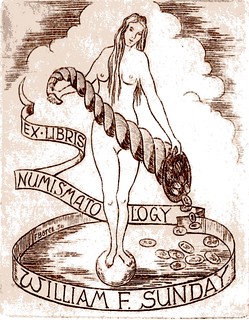 An interesting piece of numismatic memorabilia recently surfaced. It is an artist’s proof
for a bookplate. It was created in 1924 for William Sunday, 13th President of Rochester Numismatic Association.
An interesting piece of numismatic memorabilia recently surfaced. It is an artist’s proof
for a bookplate. It was created in 1924 for William Sunday, 13th President of Rochester Numismatic Association.
In those ‘pre-computer daze’ it was considered very important to have a home numismatic library - at least for your collecting specialty. On the bookplate Sunday uses the word, “Numismatology.” Is that a study of one who studies numismatics?
By the way, the “Billy Sunday” who has so many Google pages is a different person. That man was a prominent athlete and evangelist, not the RNA president.
Nick put me in touch with RNA News Assoc. Editor Ted Vaccarella, who kindly forwarded an article by Gerry Muhl on William Sunday from the March-April 2014 issue. Here's an excerpt. Thanks, guys! -Editor
William Sunday, the thirteenth RNA President, was born in 1889 in Scranton, Pennsylvania. As a young man he came to Rochester to seek work in the booming clothing industry. On December 4, 1917 he joined the coin club. Like so many other young men at the time he was soon swept up by the call of World War I. On May 2, 1918 he entered the army as a private. Applying for Officer Candidate School, he was sent to Camp Dix, New Jersey. Because of severe manpower demands he was sent overseas before finishing training and on June 20, 1918 he was promoted to sergeant.
Sunday saw action in the St. Mihiel Offensive. In the confusion of battle he was reported missing in action for over a month. Later he fought in the Limey Sector of France until May 13, 1919 when he left to return to the States. On June 5, 1919 he received his honorable discharge.
It is interesting to note how the number 13 played a role in the 13th RNA President's early life. He was13 days crossing the Atlantic; sent to the front on Friday the 13th; stayed on the front for 13 days; had "13" on rifle, bayonet, pistol and identification tags, and he started for the US on May 13. He was in the Army for 13 months.
The year 1921 was momentous for Sunday. First, he was elected RNA Secretary. More important, he married Gladys, who remained his wife for 46 years. The coin club gave him a wedding gift of a 65-piece set of sterling silver tableware. The $51 cost came from a collection taken up by the membership. In 1922 Sunday was Secretary, in 1923 Vice President, and in 1924 he was elected President.
William "Billy" Sunday was a noted collector, building a collection of early silver dollars, half dollars and cents. He often showed coins at meetings and gave presentations. One presentation in 1924 focused on the life and work of Victor David Brenner of Lincoln Cent fame.
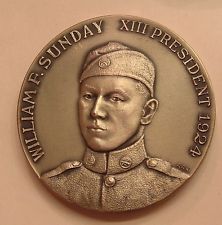 When it came to making his past president medal the club members persuaded him to wear his army uniform. New member Alphonse Kolb cut his
dies. It now is one of the most sought-after club medals. Known as the "Liberty Cap" medal, it shows Sunday wearing his military
cap. Although of the same design, the club commissioned a new reverse die in 1924 for Sunday's medal. Sunday shared his numismatic
knowledge by speaking at club meetings but also through writing. He contributed articles to the Municipal Museum newsletter. He also wrote
a weekly column in the Sunday Democrat and Chronicle newspaper. It continued through the 1930's and went under the title,
"Numismatic News."
When it came to making his past president medal the club members persuaded him to wear his army uniform. New member Alphonse Kolb cut his
dies. It now is one of the most sought-after club medals. Known as the "Liberty Cap" medal, it shows Sunday wearing his military
cap. Although of the same design, the club commissioned a new reverse die in 1924 for Sunday's medal. Sunday shared his numismatic
knowledge by speaking at club meetings but also through writing. He contributed articles to the Municipal Museum newsletter. He also wrote
a weekly column in the Sunday Democrat and Chronicle newspaper. It continued through the 1930's and went under the title,
"Numismatic News."
When not collecting coins, Sunday worked for Hickey Freeman as a trimmer and a tailor. In the 1920's he lived at 49 Rialto Street in the city, then moved to 151 Malling Drive until 1955.
At 66 he retired and moved to St. Petersburg, Florida. He died in April 1967 It is interesting to stare into the face of William F. Sunday on the RNA's 1924 presidential medal and to remember the life of this man who did much to advance the hobby.
For more information about the Rochester Numismatic Association, see:
www.the-rna.com
SUBSCRIBER PROFILE: DAVID SCHENKMAN
David E. Schenkman has been involved in numismatics since 1949, when he started collecting coins. By the mid-1950s, while still in high school, he was a serious collector of early U.S. coins. In 1960 he became interested in U.S. tokens and medals, and he is best known for that specialty. However, over the years his collecting interests have been very diverse, ranging from ancient coins to early European talers. His present interests include U.S. bust half dollars, British coronation medals, and several series of U.S. tokens, and he is an avid collector of obsolete paper money relating to mining (he is nearing completion of a catalog of these items). For many years Schenkman made a living as a professional numismatist, and also as the owner of a company that published and sold numismatic books.
Schenkman has been a member of the American Numismatic Association since 1962. He is a past president of the Token and Medal Society, and also the Civil War Token Society. His memberships in other numismatic associations include the Numismatic Literary Guild, American Vecturist Association, National Scrip Collectors Association, and various state and local numismatic associations. He is an honorary life member of the Maryland State Numismatic Association.
As an exhibitor Schenkman has been the recipient of numerous first place and best of show awards at state, regional, and national conventions, including 1977 and 1979 ANA Convention awards for best token display. He has given many talks to local, state, and regional numismatic organizations, and also ANA Numismatic Theater presentations. He has served as an instructor at the American Numismatic Association's Summer Seminar for eighteen years, teaching courses in U.S. Tokens and Civil War Era Numismatics.
Schenkman is the author of well over a hundred published articles on tokens and medals. He has written a column in The Numismatist for many years, and is presently serving as a contributing editor to The Numismatist. He has written columns for Coin World and Numismatic News. He served as editor of the Civil War Token Society's Copperhead Courier from 1975 to 1980, and from 1982 to 2010 he edited the Token and Medal Society's TAMS Journal, and all the books published by that organization during that time. He has written eight books, each of which is considered a standard reference in its specialty.
His literary efforts have earned Schenkman twenty-four literary and cataloging awards from the Token and Medal Society, including eight gold Franklin Mint/Segal awards (the only person to win this award more than twice). In 2003 the TAMS named its highest literary award, a 3” medal, the David Schenkman Literary Award, in his honor. He is the recipient of the ANA’s Heath Literary Award and the Wayte & Olga Raymond Memorial Literary Award, and has also received literary awards from the Numismatic Literary Guild, American Vecturist Association, and the National Scrip Collectors Association.
Schenkman is a two time recipient of the Token and Medal Society’s Medal of Merit. In 1980 he received the Civil War Token Society's Service Award, and in 2004 he was inducted into the CWTS Hall of Fame. He is also a recipient of Krause Publication's Numismatic Ambassador award. In 2003 he received the ANA’s Glenn Smedley award, and in 2007 the ANA’s Medal of Merit. In 2012 he received the ANA’s Lifetime Achievement Award, and in 2013 was the recipient of the Farran Zerbe award.
For more information about the Civil War Token Society , see:
www.cwtsociety.com
WEST POINT STRIKES MARCH OF DIMES SILVER DOLLAR
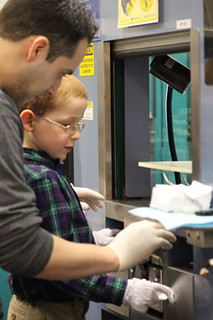 Coins can change the world, and that is the hope of the March of Dimes commemorative silver
dollar struck Wednesday at the US Mint at West Point.
Coins can change the world, and that is the hope of the March of Dimes commemorative silver
dollar struck Wednesday at the US Mint at West Point.
The face of the coin has profiles of President Franklin Delano Roosevelt and Dr. Jonas Salk. Roosevelt was disabled by polio and Salk invented the first effective vaccine against the disease.
On the tail of the coin is a tiny premature baby nestled in a parent’s hand. The two side of the coin depict the work of the March of Dimes fighting Polio and premature birth.
On hand at the Mint to strike the first of the half million coins that will be pressed were Dr. Peter Salk, son of Jonas Salk, and Aidan Lamothe, a six-year-old boy who was born 12 weeks premature and benefited from the work of the March of Dimes.
The March of Dimes, originally called the National Foundation for Infantile Paralysis, got the name we know it by today from a fundraising effort of Roosevelt who called upon Americans to send one or more dimes to the White House to help find a cure for polio. The result was literally truckloads of dimes mostly from children want to help other children get well.
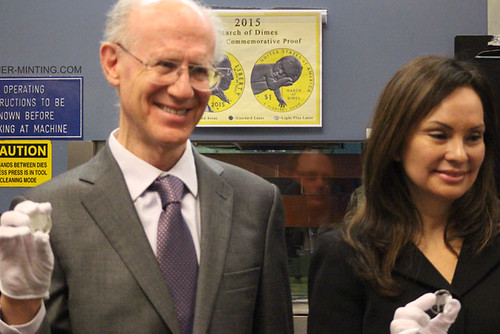
Peter Salk and U.S. Treasurer Rosa Rios
“It’s the huge number of people who contributed dime, by dime, by dime that’s all come together on this coin,” Salk said.
It’s fitting that Roosevelt who had polio himself, and is pictured on the dime, be pictured alongside Salk on yet another coin. After the costs of production are recouped by the Mint all of the proceeds from the $10 surcharge on each coin will go the March of Dimes, potentially as much as $3 million.
To read the complete article, see:
March of Dimes silver dollar struck at West Point
Mint (www.midhudsonnews.com/News/2015/March/11/MarchDimes_coin-11Mar15.htm)
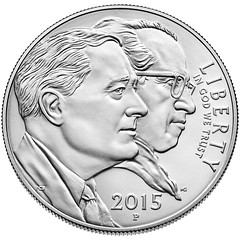
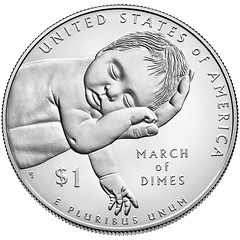
Obverse
Designer: Paul C. Balan
Sculptor: Michael Gaudioso
Description: –Representing the past–depicts a profile view of President Franklin D. Roosevelt and Dr. Jonas Salk, two leaders in the fight
against polio. The inscriptions are “LIBERTY,” “IN GOD WE TRUST,” and “2015.”
Reverse
Designer: Don Everhart
Sculptor: Don Everhart
Description: Depicts a baby cuddled in the hand of a parent, representing the foundation's dedication to the health of babies
everywhere. The inscriptions are “UNITED STATES OF AMERICA,” “E PLURIBUS UNUM,” “$1” and, “MARCH OF DIMES.”
To read the complete article, see:
http://www.usmint.gov/pressroom/?action=photo#MarchOfDimes
THE BOOK BAZARRE
HARRAH’S CASINO SANDBLASTED SILVER DOLLARS
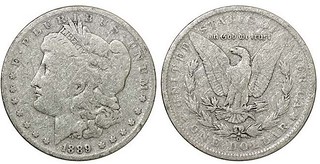 In the early 1960s, the owner of Harrah’s casino in Reno, Nev., attempted to render silver
dollars uncollectible by having their surfaces sandblasted, to keep them in casino circulation.
In the early 1960s, the owner of Harrah’s casino in Reno, Nev., attempted to render silver
dollars uncollectible by having their surfaces sandblasted, to keep them in casino circulation.
William Harrah believed that by altering the surfaces of the coins, he could stem the exodus of silver dollars leaving in the pockets of collectors and tourists wanting souvenirs.
Harrah was dead wrong. The public still removed the coins from the casino regardless of their condition.
Collector and Coin World reader James Hollowell was in the United States Air Force stationed from November 1961 to February 1965 at Travis Air Force Base, 60 miles east of San Francisco. Hollowell recollects hearing a news report one evening during that period about a casino owner in Reno who was having the dates of silver dollars removed with a grinder to negate their collectibility.
While Hollowell got the general sense of the story correct, coin expert Rusty Goe from Southgate Coins in Reno added the specifics. Goe also provided images of some of the coins that Harrah’s Casino had sandblasted.
The sandblasted 1889-O Morgan dollar illustrated with this article was brought to Goe’s coin shop a number of years ago, he said, by a former employee in Harrah’s Casino who claimed to be part of the sandblasting crew.
“The old silver dollars played an integral role in the casinos’ Western-themed persona,” Goe said. “The clanging of them dropping into the slot machines’ troughs, and the ringing and tingling sound they made when blackjack and craps dealers stacked them and paid them out to players, created an ambience that patrons loved.”
Circa 1964, Harrah became dismayed at the thousands of silver dollars being drained from the casino by the souvenir-crazy public exchanging large sums of paper for the pre-1936 cartwheels. Goe said this exchange was around the time when several casinos in Reno had ordered 1.5 million silver dollars from the Treasury Department at face value.
Goe said this was the final such order before Treasury dispersals of the coins were ended.
“Bill Harrah, in a desperate move to stem the outflow of silver dollars from his casinos, commissioned his maintenance department to sandblast them,” Goe said. “He thought that by defacing them they would retain their hefty feel and clanking sound but look so hideous that patrons would not want them for souvenirs. The plan proved ineffective and silver dollars continued to disappear at a swift pace, spurred even more so by the rising price of bullion.”
Not long after the cessation of silver dollar sales by the Treasury Department, casino owners began contracting with the Franklin Mint and other private mints to manufacture base-metal tokens as silver dollar substitutes.
To read the complete article, see:
Casino owner altered surfaces
of coins to stem exodus as souvenirs (www.coinworld.com/news/casino-owner-sandblasted-silver-dollars-to-remove-collectibility.html)
IDAHO INSANE ASYLUM TOKENS
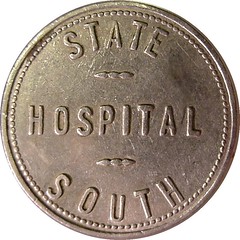
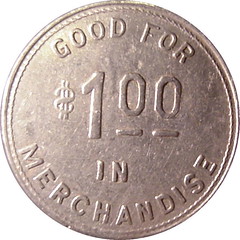
Thanks for another great issue of The E-Sylum - they are always a highlight of the weekend! The item about "lunatic asylum tokens" prompts me to write this.
The attached photos are of the $1 denomination of a set that includes 5¢, 10¢, 25¢, 50¢, and $1 round aluminum tokens from one of two such institutions in Idaho. First established by the Idaho Territorial Legislature, the Idaho Insane Asylum received its first patient in 1886 at Blackfoot, Idaho. Due to the geography of Idaho (we are considered by many to have three capitols - Spokane, WA is the one for North Idaho, Salt Lake City, UT is the one for southeastern Idaho, and Boise is the official one and the capitol of southwestern Idaho and eastern Oregon), the 1905 State Legislature authorized a second mental hospital, State Hospital North, in Orofino. In 1931, the name of the Blackfoot institution was changed to State Hospital South, and both the North and South institutions continue to the present.
In March of 1976, I called a gentleman in the business office of State Hospital South to ask about the history of the tokens, only a few examples of which were in collectors' hands at the time. He said that they were used from prior to 1950 to about 1965 in a manner somewhat analogous to prison tokens, but with one important difference. It seems that there were a number of unscrupulous attendants (he called them "Buggers") who worked in mental institutions and would cheat the patients if they had a chance. Patients who either received money from friends or relatives or earned it from work in the hospital were required to deposit the cash in the business office, and were issued tokens as needed. The hospital commissary sold candy, tobacco, etc. to both patients and staff, but tokens were only allowed for patient purchases and cash was the only medium of exchange for non-patients. The reason for using tokens and scrip in prisons is to prevent inmates from bribing staff.
Idaho's State Hospital North is a much smaller facility and apparently never used tokens.
I almost forgot to mention the backwards $ on the token - crazy, huh?
John adds:
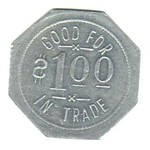 In the world of trade tokens where they were made with fewer checks for quality than a modern
mint, backwards letters and symbols are to be found. tokencatalog.com has four pages of results when searched for
"backward".
In the world of trade tokens where they were made with fewer checks for quality than a modern
mint, backwards letters and symbols are to be found. tokencatalog.com has four pages of results when searched for
"backward".
To read the earlier E-Sylum article, see:
LUNATIC ASYLUM TOKENS (www.coinbooks.org/esylum_v18n10a34.html)
MORE MENTAL HOSPITAL TOKENS
John Mutch writes:
Richard Greever's tokencatalog.com site has some more mental hospital tokens - I searched for "hospital". There may be others on his site, but the ones below are or were mental hospitals.
Battleford, Saskatchewan, Canada: Mental Hospital Battleford
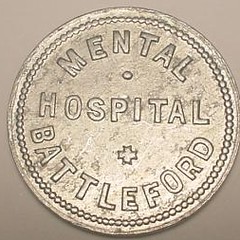
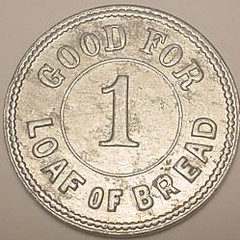
MENTAL / HOSPITAL / BATTLEFORD
GOOD FOR / 1 / LOAF OF BREAD
TC-389031 *** Image courtesy of N. Wahl*** +1925
Pueblo, CO: Colorado State Hospital
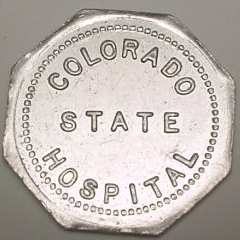
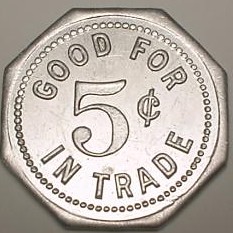
COLORADO / STATE / HOSPITAL
GOOD FOR / 5¢ / IN TRADE
TC-287500; Pritchard PU305-5a *** 21.28mm
Brainerd, MN: Brainerd State Hospital
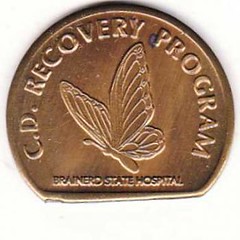
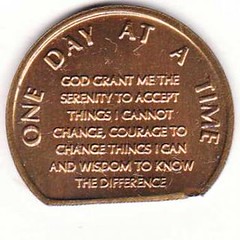
C.D. RECOVERY PROGRAM / (Butterfly) / BRAINERD STATE HOSPITAL
ONE DAY AT A TIME / GOD GRANT ME THE / SERENITY TO ACCEPT / THINGS I CANNOT / CHANGE, COURAGE TO / CHANGE THINGS I CAN / AND WISDOM TO KNOW / THE DIFFERENCE
TC-133274 *** Brainerd State Hospital 1958-Present; Once housing over 1500 patients, this now houses only 16 mentally ill patients and houses the C.D. Recovery Program as well as some Minnesota Care staff. 10 buildings were demolished in 2011.
Lincoln, NE: Lincoln State Hospital
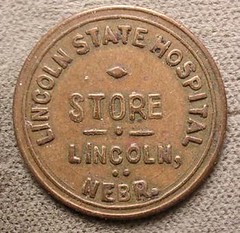

LINCOLN STATE HOSPITAL / STORE / LINCOLN, / NEBR.
GOOD FOR / CE1NT / IN TRADE {GFIT-1-CENT-6}
TC-268811 *** Image courtesy of Dick Grinolds - thank you
Yankton, SD: Yankton State Hospital

GOOD FOR / 10¢ / IN TRADE / YANKTON STATE / HOSPITAL / SNACK SHOP
(blank) (incuse)
TC-119396; Kent
San Antonio, TX: San Antonio State Hospital

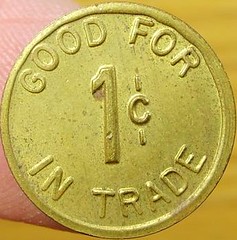
SAN ANTONIO / STATE / HOSPITAL / TOKEN STORE
GOOD FOR / 1¢ / IN TRADE
TC-147532; TX1984 *** 16.73 mm; uncommon
Montrose Lunatic Hospital
Paul Bosco writes:
There is also the Montrose Lunatic Hospital 1/2-Penny of 1799, a "Conder" token, worth $20-30 in VF. There are other European issues, late 1800s into the1900s. I once had an English agricultural prize medal awarded to a mental hospital for --I swear-- vegetables.

Montrose Lunatic Hospital 1799 halfpenny token Angusshire, Andrew Nicol Montrose halfpenny token 1799:
Obv: MONTROSE HALFPENNY 1799 around shield of arms with supporters.
Rev: MONTROSE LUNATIC HOSPITAL/ERECTED BY SUBSCRIPTION around building with the date 1781 underneath.
Edge: PAYABLE BY ANDREW NICOL TOBACCONIST x (barely visible). Manufactured by Kempson, the die-sinker was Willets.
D&H 32 listed as scarce
To read the complete sale listing, see:
Montrose Lunatic Hospital 1799 halfpenny
token (www.rarecoinsandtokens.co.uk/index.php?main_page=product_info&products_id=380)
To read the earlier E-Sylum article, see:
LUNATIC ASYLUM TOKENS (www.coinbooks.org/esylum_v18n10a34.html)

ELIZABETH HARRIS'S REPLICA VICTORIA CROSS

The remarkable story of a woman who nursed soldiers in India during a 19th century cholera outbreak and the medal they gave her in gratitude is to go on display in London.
For her “indomitable pluck”, Elizabeth Webber Harris was awarded a replica Victoria Cross, as women were ineligible for the country’s top bravery award itself during her lifetime.
Her medal will go on display at the Imperial War Museum from next month, in the wake of International Women’s Day last Sunday.
It will be in the Lord Ashcroft Gallery, which is dedicated to objects and artefacts belonging to those awarded the Victoria Cross or the George Cross.
Born Elizabeth Matthews in Bexleyheath, Kent, in 1834, Mrs Harris travelled to India with her husband, who had been made commanding officer of the 104th Regiment (Bengal Fusiliers).
Her medal was displayed for many years at the Royal United Services Institute in Whitehall and then the National Army Museum.
In 2013 it was acquired by the Lord Ashcroft Collection of British military decorations, which is permanently housed at the Imperial War Museum in Lambeth.
The medal stands as an “eloquent testimony” to all the women who lived with the British Army in Victorian India, said the museum.
To read the complete article, see:
Museum
honours nurse who is only woman to have ‘won VC’
(www.nursingtimes.net/home/specialisms/leadership/museum-honours-nurse-who-is-only-woman-to-have-won-vc/5083151.article)
CONFEDERATE HALF DOLLAR PEDIGREE RESEARCH
 When four 1861 half dollars were struck by the Confederate States of America at
the New Orleans Mint, the coins with their distinctive obverse design were given to several prominent individuals.
When four 1861 half dollars were struck by the Confederate States of America at
the New Orleans Mint, the coins with their distinctive obverse design were given to several prominent individuals.
But who?
The appearance of two Confederate 1861 half dollars at auction in the first quarter of 2015 has encouraged us to publish some recently discovered information directly related to the provenance of at least one of the four examples minted.
For 135 years, it has been accepted as fact that just four pieces of the Confederate government designed half dollar were struck at the New Orleans Mint in 1861, and it has also been accepted as truth that four individuals, whose names were revealed in an 1879 newspaper article, were the ones who received an example just off the press.
There is little question of the striking of four examples, since presently four are extant; however, recent evidence, gleaned from a statement from a gentleman who was there during the striking, may cause us to question, and even change previously held notions about who actually were the final recipients of said rarities.
In 1879, former New Orleans Mint coiner Benjamin Franklin Taylor first amazed the numismatic community when he announced in a letter, to a prominent numismatist of the time, the existence of the half dollar with a specially designed Confederate obverse.
Also in the letter, he included the names of four gentlemen he claimed had received the four pieces struck some 18 years before. Coiner Taylor noted that the first of the four Confederate pieces went to Charles Gustavas Memminger (Secretary of the Confederate Treasury), who immediately sent his to President Jefferson Davis. Another piece went to Dr. Edward Ames, a noted physician in the city, and another to Dr. John Riddell, noted scientist and college professor in New Orleans. And lastly (with the approval of the Confederate Congress) a piece went to Coiner Taylor himself.
However, some contradictory information on that same subject appeared in 1889, which could erase maybe one, or even two, of these gentlemen from the lists of recipients of said coin. An expert engraver of the time, Augustas Heinrich Marcus Peterson, furnished this astonishing news to a reporter by the name of Jorge Brisson.
We are presently working on putting together Confederate half dollar and die pedigrees that will appear in a follow-up story sometime in 2015. So far, while working with these pedigrees, we have discovered previously unreported owners of this very coveted coin. There might be some surprises in store!
To read the complete article, see:
THE 1861
CONFEDERATE HALF DOLLAR A LOGICAL, BUT SURPRISING, REVELATION CONCERNING POSSIBLE FIRST RECIPIENTS
(http://tablet.olivesoftware.com/Olive/Tablet/CoinWorldWeekly/SharedArticle.aspx?href=CWW%2F2015%2F03%2F30&id=Ar03800)
POGUE FAMILY COLLECTION EXHIBITED IN LONDON
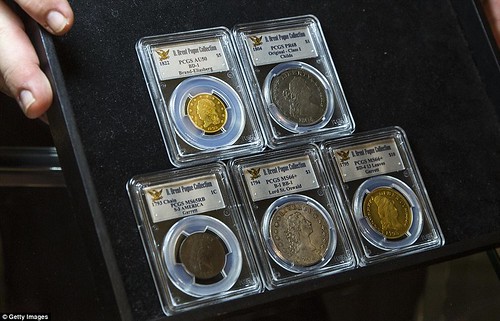
The world's greatest private collection of coins is expected to sell for $220million (£150million) in a record-breaking series of seven auctions at Sotheby's and Stack's Bowers Galleries.
Gathered over more than 30 years by Texas property developer A. Mack Pogue and his son, D. Brent Pogue, the collection contains coins from the early years of the American republic, from 1792 to the 1830s.
These are the most sought-after U.S. coins in existence, as the crude production techniques of the period meant that the coins were fragile, making surviving high-quality examples are extremely rare.
The Pogue collection includes two examples of the coveted 1804 silver dollar, considered to be the most famous coin in America, which is known as 'the pinnacle of coin collecting'.
One of these is valued at $9.8million (£6.7million). Notably, it was presented to the Sultan of Muscat in 1835.
D. Brent Pogue, from Dallas, Texas, has now decided to 'cash in his cash' by auctioning off more than 650 individual coins at a number of Sotheby's and Stack's Bowers Galleries sales over the next two years.
Experts expect the collection to sell for almost $220million (£150million), more than any other series of rare coins.
On Friday, Sotheby's showed off the jaw-dropping collection at its saleroom in New Bond Street, London.
To read the complete article, see:
The most valuable coins in the world: Texas property developer's treasured collection from the early years of the American republic is
expected to fetch more than $220MILLION at auction
(www.dailymail.co.uk/news/article-2993515/The-valuable-coins-world-Texas-property-developer-s-treasured-collection-early-years-American-republic-expected-fetch-220MILLION-auction.html#ixzz3UHrviCkM)
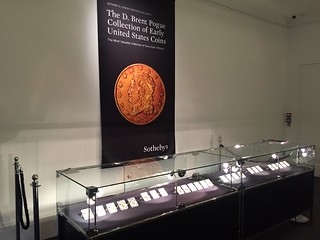
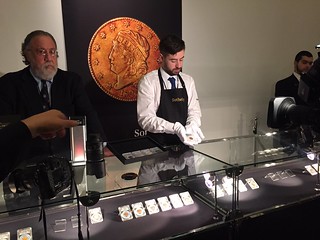

THE THOMAS B. LOCKWOOD COLLECTION
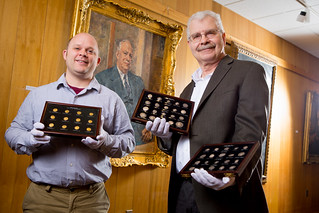 Finding a $20 bill could make your day. Find priceless, 2,500-year-old gold and silver Greek and Roman
coins, and you’ve made the discovery of a lifetime. That’s what happened to University at Buffalo faculty member Philip Kiernan, who heard
a rumor from a UB alumnus in 2010 that the UB Libraries housed the rare coins.
Finding a $20 bill could make your day. Find priceless, 2,500-year-old gold and silver Greek and Roman
coins, and you’ve made the discovery of a lifetime. That’s what happened to University at Buffalo faculty member Philip Kiernan, who heard
a rumor from a UB alumnus in 2010 that the UB Libraries housed the rare coins.
Three years later, Kiernan, an assistant professor of classics, channeled his inner Indiana Jones and journeyed to the depths of the UB archives to find them.
The collection, he was shocked to learn, was real: 40 silver Greek coins, three gold Greek coins and a dozen gold Roman coins — one from each era of the first 12 Roman emperors, from Julius Caesar to Domitian.
They range in date from the fifth century B.C. to the late first century A.D. Not your usual find.
“I must have been the first person to touch them in almost 40 years,” says Kiernan, who brought in two experts to verify the coins’ authenticity last semester and is now developing a graduate course to examine the items’ history.
It’s the first time the coins will be extensively studied, and Kiernan and his class will publish their findings.
 Within the collection is a “remarkably rare” coin of Roman emperor Otho, who reigned
for a mere three months.
Within the collection is a “remarkably rare” coin of Roman emperor Otho, who reigned
for a mere three months.
The Greek coins were struck by some of the most powerful city-states and rulers of the ancient world, such as Athens, Corinth and Alexander the Great. The coins were donated in 1935 to the UB Libraries Special Collections by Thomas B. Lockwood as part of a larger collection of rare books. However, it wasn’t until Kiernan examined them out of curiosity that the currency’s rarity and value were realized.
Kiernan focuses much of his research on ancient currency and antiquities, and the experts he brought in to examine the coins were numismatists — people who collect or study currency.
Lockwood’s collection includes more than 3,000 books, medallions and additional coins from early America and England. Other notable items include a medallion of Napoleon Bonaparte and 36 British gold coins, including one of Queen Elizabeth I.
Lockwood, an avid reader and collector of rare and special books, purchased the items to supplement his personal collection.
Accruing relics and art was common practice among affluent men in the early 20th century.
The UB Libraries will open the collection of coins to members of the campus and local communities pursuing relevant research.
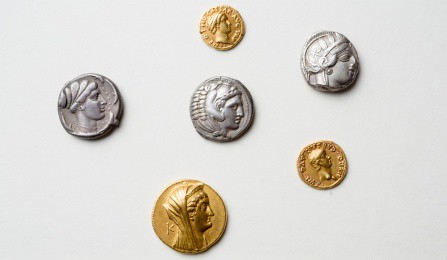
Tom Kays writes:
The library plans to "conserve" the coins, a red flag word for "harshly clean" in my lexicon. Ancient gold coins in high grade need no library conservation. Along with the coins the gift included rare books (rare for 1935) which may include books about numismatics since the benefactor had exquisite taste in antiquities and coins. That might be worth a call to the library to see if they can identify what else was donated with the coins. Do any E-Sylum readers know more about this collection based on contemporary auction catalogs?
Do any librarians within the call of The E-Sylum have similar objects sitting back in the stacks of their institutions? I know I found tokens in the stacks of the Alexandria Library on Queen Street, rare books room, but don't want to say more in the hope that they stay put for the benefit of future researchers. Apparently holding artifacts among ephemera is standard practice at libraries. Even coins. Even valuable (not priceless in the monetary sense) coins, deemed priceless in this interview from a historical standpoint with which I agree. Librarians - show us your numismatic artifacts (in an anonymous and secure manner please).
To read the complete article, see:
For 80 years, ancient gold treasure rested undisturbed in UB library
(www.buffalo.edu/news/releases/2015/03/020.html)
COCOS ISLAND TREASURE FOUND BY PARK RANGERS
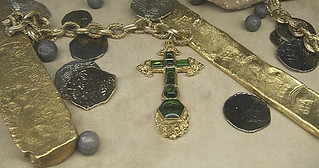 A group of Costa Rican park rangers patrolling in the Parque Nacional Isla del Coco after a recent storm,
have discovered one of the most amazing treasure hoards in modern history. The treasure consists of gold and silver coins and ingots,
jewellery, candlesticks and religious items, and is estimated to be worth almost 200,000,000$.
A group of Costa Rican park rangers patrolling in the Parque Nacional Isla del Coco after a recent storm,
have discovered one of the most amazing treasure hoards in modern history. The treasure consists of gold and silver coins and ingots,
jewellery, candlesticks and religious items, and is estimated to be worth almost 200,000,000$.
Cocos island is a small island designated as a National Park, located in the Pacific Ocean, approximately 550 km (342 mi) from the Pacific shore of Costa Rica. It was well-known for possibly holding various legendary treasures, but its “protected area” status had forbidden treasure hunting on it since 1978.
A group of six rangers who were walking around the island to evaluate the damage done by a storm on the nesting colonies of migratory seabirds, when they noticed that the tide had unearthed what looked like an old wooden box or chest. The began unearthing it, only to discover that there were actually five different chests and other items, that they had been buried there for a very long time.
“We were walking on the beach, and we saw something protruding from the sand” says park ranger Ignacio Ramirez. “We dug it out and found a bunch of old wooden chests. They were all filled with gold and silver! Then we dug out two incredible golden statues of the Virgin Mary, and other religious symbols. We called our bosses and said ‘we just found a treasure!’. They thought we were kidding, but we explained what we had found and they decided a team of experts.”
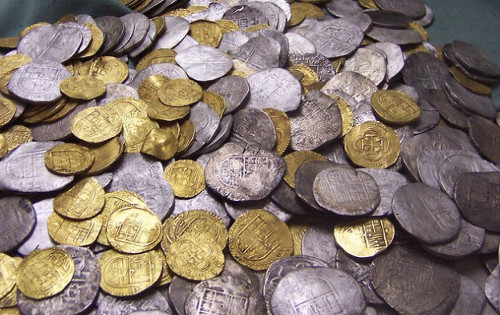
All in all, the treasure contains an astronomical 89,000 coins, ingots and artefacts of gold and silver.. Many religious items made of gold or silver and adorned with precious stones were among the findings, including 36 crosses, 3 chalices and two life-size solid gold statues of Mary holding the baby Jesus.
Many treasure legends have been associated with Cocos island for centuries. The first claim is associated with the pirate captain Bennett Graham who allegedly buried 350 tons of gold raided from Spanish galleons on the island in the 18th century. Another pirate captain, the Portugese Benito Bonito, is also supposed to have buried treasure on the island, this time in the 19th century.
Archaeologists and historians believe, however, that the discovery is actually linked to the best known of the treasure legends tied to the island: that of the treasure of Lima.
According to the legend, with the army of José de San Martín approaching Lima in 1820, Viceroy José de la Serna is supposed to have entrusted the treasure of the city to the British trader, Captain William Thompson, for safekeeping until the Spaniards could secure the country. Instead of waiting in the harbor as they were instructed, Thompson and his crew killed the Viceroy’s men and sailed to Cocos island, where they buried the treasure.
Hundreds of attempts to find treasure on the island have failed. Prussian adventurer August Gissler lived on the island for most of the period from 1889 until 1908, hunting the treasures with the small success of finding six gold coins.
Since it was discovered in a National park, the totality of the treasure is now the property of the Costa Rican government, and it should be exposed at the Museo Nacional de Costa Rica, in San José. The rangers who discovered the treasure have been promised a reward for their role in the finding, but the amount of the reward remains undisclosed.
From our Flickr archive, RETRO_STU writes:
A totally awesome find! Hope all those Park Rangers get enough rewards to retire on. Kudos to their honesty and integrity for handing up the treasure so it can be preserved for posterity and humanity to enjoy for generations to come. A truly amazing treasure hoard.
The Cocos Islands have always been renowned for their fantastic tales of buried pirate treasure. This find lends credence to those stories.
To read the complete article, see:
FABULOUS 200 MILLION DOLLAR
TREASURE HOARD UNEARTHED IN COCOS ISLAND
(http://worldnewsdailyreport.com/fabulous-200-million-dollar-treasure-hoard-unearthed-in-cocos-island/)
COINS FOUND IN A CAVE IN ISRAEL
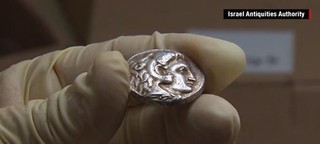 Zakai was recently spelunking with his father and a friend, all of whom are members of the Israeli Caving
Club, when Zakai spotted a shiny silver object in one of the most well-hidden stalactite caves in northern Israel.
Zakai was recently spelunking with his father and a friend, all of whom are members of the Israeli Caving
Club, when Zakai spotted a shiny silver object in one of the most well-hidden stalactite caves in northern Israel.
As Zakai moved in for a closer look, he found two ancient silver coins stashed inside a nook. The coins were meant to be hidden, perhaps to be retrieved at a later date. Instead, they lay in secret for more than 2,000 years in a small hoard that will give archaeologists a valuable insight into ancient Israel.
"We saw the pictures of some of the items that were found in the cave," says Eitan Klein, deputy director of the Antiquities Theft Prevention Unit at Israel Antiquities Authority, "and we understood that we are talking about something very, very unique."
The two silver coins were minted during the reign of Alexander the Great, who conquered the region in the late fourth century B.C. On one side of the coin is an image of Alexander the Great, while on the other side is an image of Zeus sitting on his throne, arm raised as if ready to wield his fearsome lightning bolts. The coins allowed archaeologists to date the find.
Along with the coins were pieces of silver jewelry, including rings, bracelets and earrings. The whole cache is thought to have been originally contained in a cloth pouch.
"The valuables might have been hidden in the cave by local residents who fled there during the period of governmental unrest stemming from the death of Alexander, a time when the Wars of the Diadochi broke out in Israel between Alexander's heirs following his death," said the Israel Antiquities Authority.
There are many unexplored crevasses in the cave, according to archaeologists, and perhaps many more priceless caches to discover.
To read the complete article, see:
Cavers find treasure from era of Alexander
the Great in Israel (http://edition.cnn.com/2015/03/09/middleeast/israel-ancient-treasure-found-in-cave/)
To read the complete article, see:
Watch:
Rare 2,300-year-old silver and bronze coins, jewelry found in ancient northern cave
(www.jpost.com/Israel-News/Culture/Rare-2300-year-old-silver-and-bronze-coins-jewelry-found-in-ancient-northern-cave-393360)
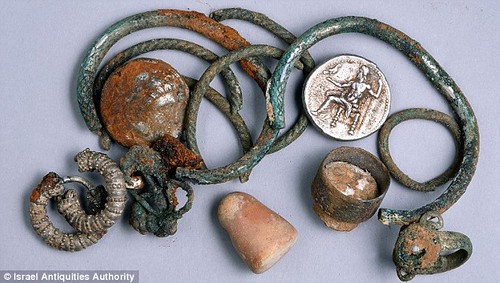
To read the complete article, see:
Israel's cave of wonders: Silver coins and treasure dating back 2,300 years to Alexander the Great discovered
(www.dailymail.co.uk/sciencetech/article-2986454/Israel-s-cave-wonders-Silver-coins-treasure-dating-2-300-years-Alexander-Great-discovered.html)

ARTICLE REMOVED
WAYNE’S NUMISMATIC DIARY: MARCH 15, 2015
February was a short month, so the March meeting of my Northern Virginia numismatic social group Nummis Nova seemed to come around fast. Our host Tuesday night was Joe Levine. Traffic was awful, and I arrived about 7pm at Esposito's restaurant in Fairfax. It was raining and I put up my umbrella for the short walk to the door.
Our party was seated just inside, and I waved thru the window. I took an empty seat at the close end of the table across from Gene Brandenburg and next to Lenny Goldberg. Besides Joe and a guest sitting next to him (more later), attendees included Julian Liedman, Wayne Herndon, Mike Packard, Jon Radel, Steve Bishop, Dave Schenkman and Eric Schena.
Your Most Treasured Numismatic Item
Joe had previously declared the exhibit theme for the evening: "My most treasured numismatic item. If times got bad and you had to raise money to feed the family, what would be the last numismatic item you would sell?"
Interesting thought experiment. Since I'd already sold off much of my collection itself, I turned my thoughts to my library. It was a tough choice, but I decided to pick my copy of the 1851 Roper sale, a rare item from a landmark event in American numismatics. It was Mark Collet's copy, priced and partially named. As an exhibit though, it doesn't look like much, and to protect it from spaghetti sauce, olive oil and wine, I decided to leave it at home. How would E-Sylum readers answer that question?
Eric and Dave were among those close enough to talk to at my end, and topics ranged from wine, decanting and silver decanters, coin dealers, favorite numismatic purchases, and a world leader nicknamed "Spanky" (don't ask).
The Six-Cent Nickel
Back on numismatics, I learned from Gene that Wayne Herndon was paying six cents for nickels dated prior to 1960. Ever one to take advantage of a new opportunity, before I'd arrived Gene gave Wayne a nickel and asked for a receipt, which Wayne made out on the spot. But not before Gene told him that he and Dave Schenkman were joint owners of the coin, so he'd need to issue TWO three-cent checks. I missed out on the fun, but will check my change more carefully - a 20% return is a 20% return. Beat THAT with the stock market...
1902 Winchester, VA Sesquicentennial Medal
1882 $50 gold certificate
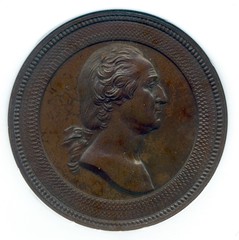

Eric provided an image of one of his exhibit items. He writes:
As always, I had a lovely dinner at Nummis Nova. Here are scans of an item I just got that night courtesy of Dave Schenkman. It is a 32 mm diameter bronze medal commemorating the sesquicentennial of Winchester, Virginia and July Fourth celebrations in 1902. The medal has a beautiful high relief bust of George Washington on the obverse and is listed as Baker-1833. I have not run across one of these in my travels in the area. The photos don't do it justice - it's quite stunning.
For the dinner's theme of "last numismatic item you'd part with," I brought an 1882 $50 gold certificate, FR-1196 Vernon-McClung, that was one of my first bigger numismatic purchases back in 1985. I got the note from a dealer who had a small shop in a strip mall in southern Fairfax County off of Route 1. I wanted a large denomination note and really wanted a gold certificate and a friend of mine said he had all sorts of neat notes. Turns out he had a small group of six of the type, all but one as it turned out were the much more common (relatively speaking) FR-1197 Napier-McClung notes.
I was just a "tween" then and all I noticed at the time was that it was a different sig combo so I picked that one for $180. I kept it and just a few years ago sent it to PMG who gave it a VF-25 grade. It's a rarer Friedberg number (perhaps 30 or so known in any grade). I still have the thing and will for some time to come. I wish I remembered the name of the dealer - he had stacks of currency, in particular high denomination notes. It was the first time I ever handled $500 and $1000 notes which is pretty heady stuff for a young kid!
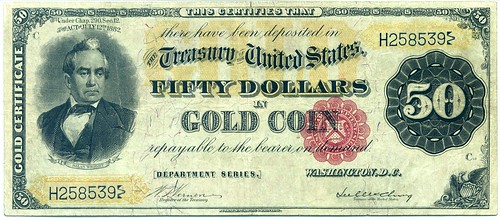
It was a nice note. Great taste! This kid will go far. Oh wait, he already has - not only as a numismatic author and editor, but as a cataloguer for Stack's Bowers.
Engraver Ad Note and Token
Next up are some images of Dave Schenkman's other items. Here's an advertising note for an engraver, an unusual issuer for items of this type.

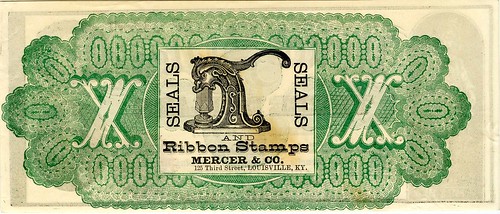
Dave also had a great token none of us had ever seen before - the Key token with Monitor reverse in silver. The Key company were engravers & die sinkers in Philadelphia.
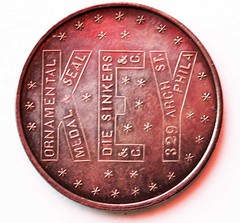
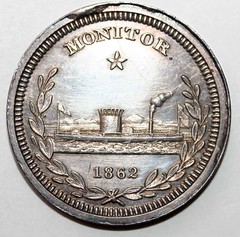
Dave writes:
To the best of my knowledge it is unique. It came out of a Bowers & Ruddy sale back in the 1970s, as I recall.
TAMS Franklin Mint Literary Award Medals
Lastly, Dave brought one of his Token and Medal Society Franklin Mint Literary award medals. He writes:
I brought this to the dinner because the theme was “If times got bad and you had to raise money to feed the family, what would be the last numismatic item you would sell?" Thanks to the Franklin Mint, for many years the highest TAMS literary award medal was approximately 5.5 ounces of 14kt gold. I was honored to receive eight of them.
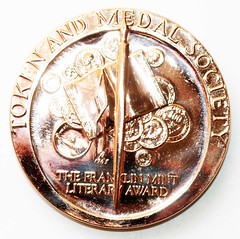
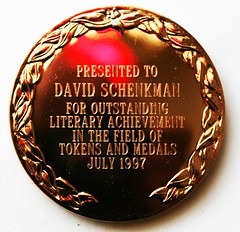
That had to be the highest-paid part-time writing gig anywhere in numismatics. These are impressive medals - wow! Dave earned them.
Jimmy Hayes
Down at the other end of the table there was a gentleman whose name I didn't know. I'd run into him once at Joe Levine's table
at a Baltimore coin show few years ago, and we chatted about our collecting interests. I didn't get his name.
Since our area was pretty cramped, I didn't get a chance to get up and visit with the other end of the table. On the way out though, Joe introduced his guest to those of us at our end of the table. He was Jimmy Hayes, the former Congressman from Louisiana.
As politician, his ad-libbed lines were well-rehearsed. A moderate Democrat, he later switched to the Republican party. When someone chided him for "going over to the dark side," he laughed and said, "The sides are ALL dark - there IS no bright side to this business..." and "When I switched, BOTH sides of the aisle got up and applauded..."
Hayes had assembled a fabulous collection of U.S. coins which was sold by Stacks many years ago. He's still a collector and lobbies Congress on various coinage issues. I'm sorry I didn't get a chance to talk more with him. For more information, see his Wikipedia entry.
To read the complete Wikipedia article, see:
Jimmy Hayes (http://en.wikipedia.org/wiki/Jimmy_Hayes)
It was going on 9:30 when I left to head home. It was still raining, and the precipitation combined with the snow-covered ground to make a pretty dense fog. But I made it home still in time to see my family and walk the dog before calling it a night. 'Til next time!
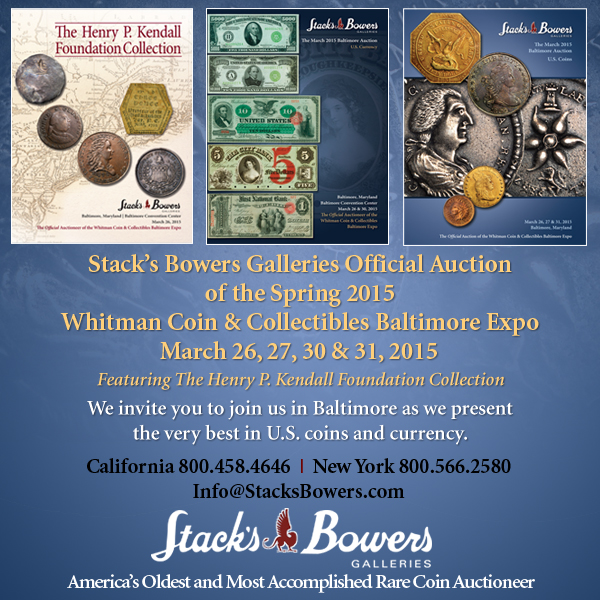
BELGIUM'S WATERLOO COIN DESIGN UPSETS FRANCE
 The French government is attempting to block a coin commemorating the Battle of Waterloo, claiming it
is a “symbol that is negative” and would undermine the unity of the eurozone.
The French government is attempting to block a coin commemorating the Battle of Waterloo, claiming it
is a “symbol that is negative” and would undermine the unity of the eurozone.
In an extraordinary intervention, France wants to block plans for a €2 coin to celebrate the 200th anniversary of the historic battle fought by the Duke of Wellington against Napoleon Bonaparte in 1815.
A draft design of the coin was submitted to the Council of the European Union by Belgium, the site of the battle, in February this year.
However, just days later France objected to the coin, claiming it could cause “hostile reactions in France” and undermine the eurozone.
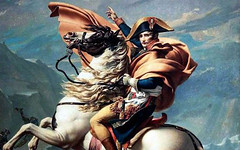 "The Battle of Waterloo is an event with particular resonance in the collective conscience, going beyond a simple military conflict,”
the letter states.
"The Battle of Waterloo is an event with particular resonance in the collective conscience, going beyond a simple military conflict,”
the letter states.
"The circulation of coins carrying a symbol that is negative for a fraction of the European population to us appears prejudicial, in a context where the governments of the Eurozone are trying to strengthen unity and co-operation throughout the monetary union."
The Battle of Waterloo on June 18, 1815 stopped the advance of Napoleon across Europe and sent the French emperor into exile for a second and final time.
The battle was fought near the town of Waterloo in modern-day Belgium.
To read the complete article, see:
French try to block Battle of
Waterloo coin (www.telegraph.co.uk/news/politics/11462782/French-try-to-block-Battle-of-Waterloo-coin.html)
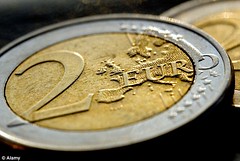 The
attempt to block the coin was met with defiance by ex-defence minister Sir Gerald Howarth.
The
attempt to block the coin was met with defiance by ex-defence minister Sir Gerald Howarth.
He told The Sun: 'This is an absolutely absurd thing to do. The battle was the salvation of Europe from a tyrannical threat.'
Sir Peter Luff, the Tory MP for Mid Worcestershire, added: 'I'm delighted the Eurozone should celebrate the failure of France to create a super-state.
Brussels has struggled to find evocative designs for Euro notes and coins because there are no true EU figures respected across the continent.
Choosing a famous person or even a monument from one country risked offending others, so the notes portray bland, undefinable architectural shapes and a simple map of Europe.
Coins have a map of Europe on one side, while each country chooses a design for the other.
David Pickup adds:
There should be a commemorative for Agincourt later this year! I wonder the French will say about that!
To read the complete article, see:
Is
this the euro’s Waterloo? Paris tries to block coin marking 200th anniversary of Napoleon’s final defeat because it will upset the French
people (www.dailymail.co.uk/news/article-2989209/Paris-tries-block-Waterloo-200th-anniversary-coin-upset-French-people.html)
Two hundred years after Napoleon’s ambitions to rule Europe died at Waterloo, France won a small battle on Wednesday to prevent the minting of a euro coin commemorating an event that shaped today’s continent.
Belgium withdrew a proposal to strike a special 2-euro piece in honour of the Anglo-Dutch-German victory outside Brussels on 18 June, 1815, an EU official said, averting an EU ministerial vote after Paris objected on the grounds that glorifying a time of conflict ran counter to efforts to foster European unity.
There was no immediate comment from France, which last year struck a commemorative 2-euro coin marking the 70th anniversary of the Normandy landings that helped end Nazi German hegemony.
To read the complete article, see:
France wins
second 'battle of Waterloo' after commemoration coin dropped
(www.theguardian.com/world/2015/mar/12/france-wins-second-battle-of-waterloo-after-commemoration-coin-dropped)
ARTICLE PROFILES CANADIAN COIN DESIGNER RICHARD HUNT
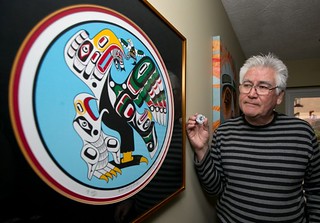 Richard Hunt’s image on Canada’s newly minted $10 silver coin shows a mother eagle giving a
minnow to her eaglet, while the father flies toward them carrying a salmon.
Richard Hunt’s image on Canada’s newly minted $10 silver coin shows a mother eagle giving a
minnow to her eaglet, while the father flies toward them carrying a salmon.
Called Mother Feeding Baby, it highlights the value of the family and also recognizes the importance of the eagle to the renowned Victoria artist, who now has three of his artistic creations emblazoned on Canadian coins.
“The eagle is the main crest of our village,” said Hunt, whose family is Kwakwaka’-wakw and is based in Fort Rupert, near Port Hardy.
The coin — the third Hunt has created for the Royal Canadian Mint — contains a hologram, what the mint calls a combination of aboriginal art and modern technology. It was produced last week in a run of 10,000. The design is based on a print Hunt created in 2007 to give to people involved in a Big Brothers Big Sisters of Victoria golf tournament.
Hunt’s relationship with the mint began when the Crown corporation contacted him about using his work for a coin minted in 2005. That coin showed two native groups coming together, while a second one he designed in 2012 to mark the 25th anniversary of the loonie featured two loons kissing.
“The good thing about the mint is they’re using native people instead of people that do native art,” Hunt said. “I’m just glad that they picked my work; they like my work.”
“I’ve done this for 50 years,” he said. That includes time at Thunderbird Park under the tutelage of his late father, Henry, as an apprentice carver.
He went on to serve as chief carver in the park’s carving program for 12 years before striking out on his own. Over the years, he has been awarded the Order of B.C., the Order of Canada and an honorary doctorate from the University of Victoria.
His UVic doctorate came in 2004, 21 years after his father received the same recognition.
To read the complete article, see:
Victoria artist leaves
mark on new Canadian $10 coins (www.timescolonist.com/news/local/victoria-artist-leaves-mark-on-new-canadian-10-coins-1.1789781)
ALAN KELLY ON ISLE OF MAN PAPER MONEY
 Although I had collected stamps and tea cards as a young lad it wasn’t until 1962, aged 11, that I
acquired my first Manx coin. My parents had been on holiday in Dublin and they bought me an 1839 Isle of Man penny, which they saw for sale
in the window of Kevin O’Kelly’s shop at Wellington Quay, priced at two pounds ten shillings. That coin started me off and I was soon
adding to the collection. In 1968 I started work in a local bank, which gave me access to quantities of coin and I regularly took £100 of
silver coin to check for rare dates and pre-1947 silver coins during my lunch break. Any proceeds from the sale of coins found were used to
finance additions to my Manx collection.
Although I had collected stamps and tea cards as a young lad it wasn’t until 1962, aged 11, that I
acquired my first Manx coin. My parents had been on holiday in Dublin and they bought me an 1839 Isle of Man penny, which they saw for sale
in the window of Kevin O’Kelly’s shop at Wellington Quay, priced at two pounds ten shillings. That coin started me off and I was soon
adding to the collection. In 1968 I started work in a local bank, which gave me access to quantities of coin and I regularly took £100 of
silver coin to check for rare dates and pre-1947 silver coins during my lunch break. Any proceeds from the sale of coins found were used to
finance additions to my Manx collection.
In 1969 I was introduced to Hilary Guard, of The Hydro Hotel, Douglas, and he persuaded me to start collecting Manx banknotes as well as the coinage. Hilary had been collecting for about five years at this stage and had already built up a fairly good collection of banknotes. I was earning little money at this time, but I did have very good contacts throughout the banking sector in the Island, so we planned a campaign to find the rarer Manx notes. Hilary placed an advert in every local newspaper, which he ran for the next ten years – ‘£50 paid for any Manx banknote not in my collection’. If he acquired any duplicates he passed them onto me. In return I used my contacts in the banks, particularly cashiers, to keep any pre-1961 banknotes for me that were paid in over the counter. This happened regularly at that time and we had some amazing ‘finds’, the most remarkable being a pair of provisional issue Martins Bank Limited £1 notes of 1928 paid into one of the banks in Douglas. The Martins banknote registers show that only three notes of each date, 9th October and 3rd November, 1928, can possibly exist and here we had one of each date, both in very fine condition. Three of the five note issuing banks, Barclays, Lloyds and Martins, still carried, as part of the cash, a batch of their pre-1961 note issues, so if I had a tatty example of one of their notes they would allow me to swap it for a better conditioned note! Martins Bank even had a block of uncirculated £1 notes of the last issue, 1st February, 1957, which they would allow me to swap.
There was very little collector interest in banknotes at this time. Hilary and myself were the only collectors on the Island, with one part-time coin and banknote dealer called Frankie Quayle, who had a stall on a Saturday in Douglas Market. In England the only Manx banknote collectors were Leslie Morgan and Godfrey Burr, with the one dealer being David Keable, of Croydon, to whom Hilary and myself supplied our surplus Manx banknotes for many years. Thanks to Kenny Morrison, the Chief Cashier at the Isle of Man Bank Limited, Douglas, Hilary and myself were also able to acquire the first fifty, and last fifty, banknotes for each prefix of new Isle of Man Government issues.
I issued Manx coin and banknote sales lists regularly through the early 1970’s, but in May, 1977 I decided it was time to go full-time dealing, so I left the bank and ran the business by mail-order from my home in Douglas. Hilary retired from the hotel in the late 1970’s and decided to sell his collection in 1979 to finance his retirement. I couldn’t afford to buy it at that time, so Stanley Gibbons bought it and sold it on, as a collection, to an investor. Luckily, he kept the collection intact and when he decided to sell in 2003 I was able to purchase it and bring it back to the Island. In 1985, I formed a limited company, Mannin Collections, and in October, 1989 we purchased the shop in Peel, from where we still operate today. We now deal in all aspects of Manx collectables including coins, banknotes, stamps, postcards, books, maps, prints, watercolours and oil paintings.
Special mention should be made of the major contribution that the late Ernest Quarmby, of Lancaster, gave to Manx banknote collecting. He approached Hilary Guard in 1969 with the idea of researching and publishing a book on the history of Manx banks and their banknotes, which Spink and Son published in 1971 as Banknotes & Banking in the Isle of Man 1788-1970. A second edition of the book was published by Spink in 1994. Few records of the early banks had survived, but Ernest meticulously researched what little information there was available and a fine job he did of it.
Finally, I wish to thank Pam and Pete West for all their hard work in gathering together the information for this publication. A considerable amount of new information has turned up since 1994, including some newly discovered banknotes, and the Isle of Man Government issues have been brought up-to-date.
For more information, or to order, see:
www.britishnotes.co.uk/?page=stock_item&categoryid=18&stockid=28798
THE BOOK BAZARRE
ARE THE DAYS OF PHYSICAL CASH NUMBERED?
The War on Cash rages on and every day we are bombarded with news that the death of the banknote and the coin is becoming more imminent. Many times we in the currency industry have fought the good fight and pushed back against the upstart competition. Perhaps it is time to look at this perpetual competition in a different way.
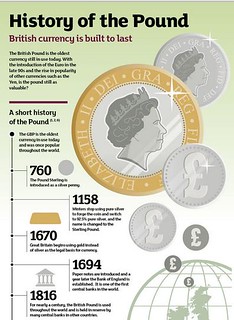 Many people ask questions like, “how long will hard currency remain as a payment option?” or, “why is currency in circulation increasing?”.
The most common answers are often born from the emotional perspective of one involved in the currency industry. An associate of mine at
Sainsbury’s Bank in the UK was kind enough to recently share with me an infographic depicting the history of coins and banknotes – from a
UK perspective. We thought it might be interesting to compare the history of coins and banknotes to that of the credit card, being one of
the oldest alternative forms of payment. Again, my friend at Sainsbury’s Bank was kind enough to send me another infographic depicting the
history of credit cards.
Many people ask questions like, “how long will hard currency remain as a payment option?” or, “why is currency in circulation increasing?”.
The most common answers are often born from the emotional perspective of one involved in the currency industry. An associate of mine at
Sainsbury’s Bank in the UK was kind enough to recently share with me an infographic depicting the history of coins and banknotes – from a
UK perspective. We thought it might be interesting to compare the history of coins and banknotes to that of the credit card, being one of
the oldest alternative forms of payment. Again, my friend at Sainsbury’s Bank was kind enough to send me another infographic depicting the
history of credit cards.
After reviewing the two infographics it seemed obvious to us that one of the major reasons for the persistence of physical currency could well be the fact that it is so ingrained in our societal habits as a fundamental part of our sense of community. Just look at the figures – physical currency has been in existence since roughly 760 A.D. – the credit card, in its initial incarnation (which was not a card at all) only became a reality in about 1880 A.D.. Simply put, physical currency has more than a 1,000 year advantage over any other form of payment in terms of building trust, accessibility and iniquitousness as an instrument of payment. That is our opinion, for what it is worth (couldn’t resist that pun!). Have a look at the following infographics and let us know what you think.
To read the complete article, see:
Old and Stable Versus Young and Restless
(http://countingoncurrency.com/news-item/old-stable-versus-young-restless/)
To view the original Sainsbury graphics, see:
History of the Pound
(www.sainsburysbank.co.uk/money-matters/history-british-pound.shtml)
MAN JAILED FOR PASSING COUNTERFEIT £1 COINS
A ‘foolish’ man who tried to exchange fake £1 coins at a Rossendale Post Office has been jailed. David Crompton entered Crawshawbooth Post Office with a bag of 500 counterfeit £1 coins and tried to exchange them for Euros. Burnley Crown Court heard how he was ‘turned away’ and later arrested in Burnley. When interviewed he told police he got the money from a bank and later claimed he won it ‘playing poker’ When officers attended the scene Crompton, of Milnrow Road, Rochdale, tried to flee but was caught with the bag of counterfeit coins. He told police ‘him and his mates’ were going on a ‘lads holiday’ and got the money from the bank before later claiming it was through playing poker. Mr Longworth said: “Even thought it was a clumsy operation, it was clearly planned by the defendant and quite possibly others.” udge Jonathan Gibson said the coins ‘looked bright and new’ however several had old dates on them. Sentencing, he said: “No doubt if a person was looking at them in a casual, for example a small number were being passed at a shop, they might well go unnoticed. Under the trained eye they were very soon seen as false.”
To read the complete article, see:
JAILED: Man who tried to exchange 500 fake £1
coins at the Post Office (www.rossendalefreepress.co.uk/news/jailed-man-who-tried-exchange-8802929)
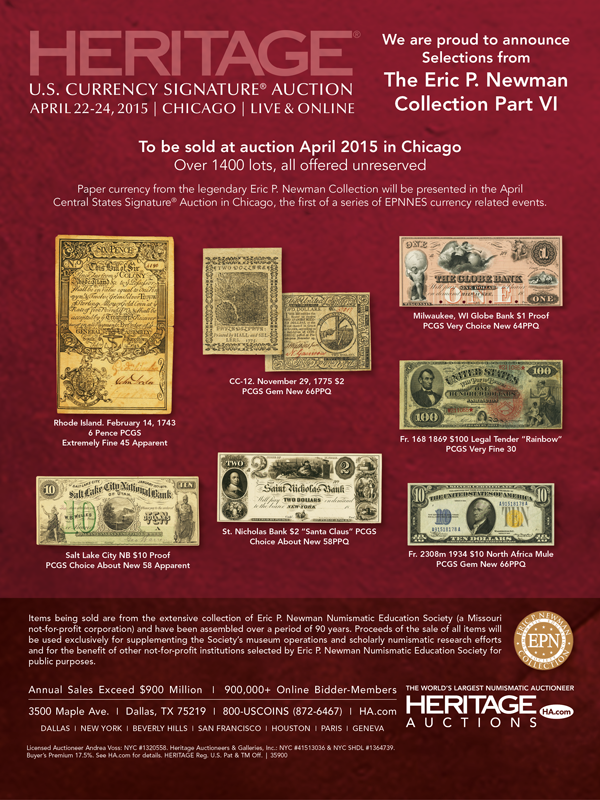
HOW DO TOY BANKNOTES GET PAST CASHIERS?
Police in Northern Ireland are searching for a suspected fraudster after a sandwich shop in Newry accepted a toy 100-euro note. It seems like a silly mistake by the member of staff, but was it a forgivable one, asks Justin Parkinson.
The note, produced by the Early Learning Centre, features a picture of a "Georgian doll's house" on one side and the letters "ELC" on the other, and a small ELC motif instead of the European Union's flag. Reports have contained much mirth over the shop assistant or shopkeeper's apparent gullibility.
But could someone using toy money have achieved the same deception if offering pounds instead of euros?
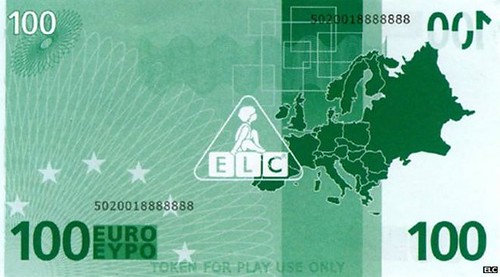
"The Bank of England does not give authority for any reproductions in the form of a novelty banknote (eg, one where a celebrity or other images are shown on a banknote or other such changes)," it says in its guidelines. "This is because there have been instances of notes altered in this way being accepted as genuine banknotes by unsuspecting members of the public."
There seems little chance of the Early Learning Centre's "£10 note", for instance, getting past even the laxest cashier. A gently smiling cartoon lion replaces the Queen and the message "Token for play use only" is printed more prominently than on its euro offerings.
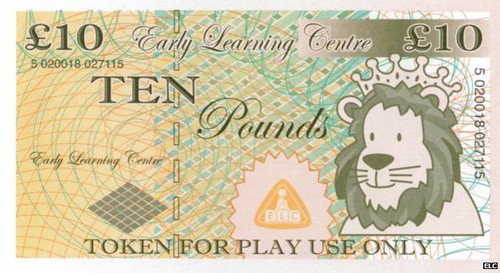
The European Central Bank, which sets reproduction rules for euro notes, is less prescriptive than the Bank of England. It states that they should be big or small enough to avoid confusion.
The Early Learning Centre's 100-euro note measures 147mm (about 5½in) by 82mm, the same size as the real one. But looking at it for more than a split second would show it is not real, and the smooth, thick paper it is printed on should be a giveaway.
"This is not something for the ECB," says a spokesman, when asked about the production of toy euros. "If at all, it would be covered by national legislation." The euro is, of course, not legal tender in Northern Ireland or the rest of the UK, but many shops accept it as payment.
To read the complete article, see:
How do toy banknotes get past cashiers?
(http://m.bbc.com/news/blogs-magazine-monitor-31851805)
THE BOOK BAZARRE
MORE 'COUNTERFEITING IN REVERSE' SCAMS
A CONMAN posing as a policeman tricked an 81-year-old woman into handing over £1,000 of her savings.
The trickster barged his way in to the woman’s house, telling her he believed she had counterfeit money and he needed to check her bank notes.
The victim, who the Echo has chosen not to name, said: “I opened the door and the man said he was a police officer and he believed I had counterfeit money in the house.
“I went upstairs to get my money and he followed me up. He was being very bullying.
“He then put the money in to his pockets and left.
Earlier this week the Echo reported how a man, also posing as a police officer, swindled a 94-year-old woman out of £800.
He went to the woman’s house in Friern Gardens, Wickford and told the elderly pensioner he needed to “check her paper money”.
The victim let him in to her home and he asked to see where she kept her cash.
He snatched the money and fled the property.
To read the complete article, see:
Conman
posing as cop tricks woman into handing over £1,000 (www.halsteadgazette.co.uk/news/south_essex_news
/11854736.Conman_posing_as_cop_tricks_woman_in_to_handing_over___1_000/)
To read the earlier E-Sylum article, see:
COUNTERFEITING - IN REVERSE (www.coinbooks.org/esylum_v18n09a38.html)
JACK THE COIN-SWALLOWING CAT
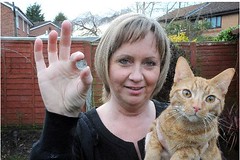 MEET the mischievous moggy who attempted to turn himself into a kitty bank after swallowing a 5p
piece.
MEET the mischievous moggy who attempted to turn himself into a kitty bank after swallowing a 5p
piece.
Vets were stunned to find the silver coin in tiny 10-month-old Jack's tummy after dealing with a number of dogs who had eaten household objects but never a cat.
The discovery was made after owner Debra Leatherbarrow, from Cinnamon Brow, took her kitten to be checked over after he kept being sick.
She added: "He had some blood tests and then an x-ray where they found the coin.
"The vet said it was really unusual for a cat and he had to have an emergency operation."
Debra has kept the coin as a 'souvenir' after Jack has appeared to have made a full recovery from his ordeal but she is now very wary of leaving anything on the floor.
To read the complete article, see:
£1,500 vet bill after kitten
swallows 5p coin (www.warringtonguardian.co.uk/news/11847045.__1_500_vet_bill
_after_kitten_swallows_5p_coin/)
WOMAN BURNS CASH STASH BY MISTAKE
 A
Chinese woman sent £20,000 up in smoke after stashing the cash in a wood burning stove and then forgetting it was there.
A
Chinese woman sent £20,000 up in smoke after stashing the cash in a wood burning stove and then forgetting it was there.
Hao Bin, 35, wanted to keep the money safe until it was needed to pay workers at her husband's construction business, and hid it inside the stove to keep it out of sight.
But the next morning, forgetting it was there, she lit the stove to make herself a cup of tea - and only realised when she went to aadd more wood.
Mrs Bin threw water onto the remains and rescued some charred notes, but was told by the Bank of China that they were in too poor a condition to be exchanged.
It's comparatively common to keep large sums of cash at home in China, thanks to a widespread mistrust of banks. Unsurprisingly, this can frequently lead to accidents such as the Bins'.
To read the complete article, see:
Woman sets fire to £20,000 by mistake
(http://money.aol.co.uk/2015/03/09/woman-sets-fire-to-20-000-by-mistake/)
